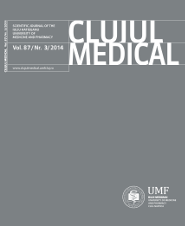Correlations among parental and neonatal anthropometric parameters, feeding practices and infant obesity
DOI:
https://doi.org/10.15386/cjmed-294Keywords:
newborn, infant, macrosome, obesity, feedingAbstract
Background and aims: Infant and adult obesity is becoming a real public health concern in Romania, similar to other countries of the European Union. Maternal obesity and excessive weight gain during pregnancy are proven risk factors for the obesity of the child. The protective role of the breastfeeding against obesity has also been demonstrated. The most important issue is whether the choice of a milk formula with the right protein composition could or not protect the newborn from becoming a future obese infant and child.Our study aims to describe the characteristics of a group of macrosomic newborns,in relation to the mothers’ weight gain during pregnancy, mode of delivery, birth weight, complications at birth, time of first feeding and type of feeding during maternity stay.
Patients and methods: we conducted a retrospective study on 179 newborns with birth weights > 4000 grams, born over a period of three months (March-May) in 6 large maternity hospitals in Romania.
Results: the newborns had a mean gestational age of 39.5 weeks and a mean birth weight of 4195 grams. Male newborns were prevalent (74%). More than half were born by Cesarian section and had Apgar scores with a median of 9. Macrosomes are prone to complications at birth and in our study those were mainly hypoglycemia and birth trauma. Time at first feeding was 95 minutes (mean), with a high percentage of formula/mixed feeding (68%).
Conclusion: Macrosomia itself attracts the risk of birth by cesarean section (54% of study group), birth trauma and a low rate of exclusive breast milk feeding (32% of study group) at discharge.
Downloads
Published
2014-08-05
How to Cite
1.
Sabau D, Stamatin M, Stoicescu S, Filip V, Cucerea M, Ognean L, Blaga L, Avasiloaiei A, Simionescu B, Miu N. Correlations among parental and neonatal anthropometric parameters, feeding practices and infant obesity. Med Pharm Rep [Internet]. 2014 Aug. 5 [cited 2025 Nov. 5];87(3):166-70. Available from: https://medpharmareports.com/index.php/mpr/article/view/294
Issue
Section
Original Research
License
The authors are required to transfer the copyright of the published paper to the journal. This is done by agreeing to sign the Copyright Assignment Form. Whenever the case, authors are also required to send permissions to reproduce material (such as illustrations) from the copyright holder.

The papers published in the journal are licensed under a Creative Commons Attribution-NonCommercial-NoDerivatives 4.0 International License.

